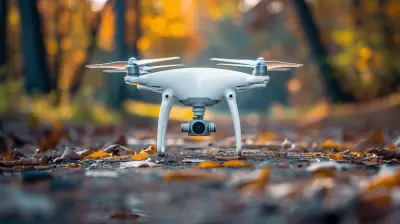How 5G is Paving the Way for Immersive Content Creation
17 February 2025

Introduction: The Leap from 4G to 5G
We’ve all been there—waiting for a video to buffer, a website to load, or your favorite game to stop lagging. Just when we thought 4G was fast enough, 5G came marching in, promising to revolutionize not only the way we browse the internet but also how we create and consume content. And let’s be honest, it's not just any content we're talking about—it's immersive content.Now, when I say "immersive content," I’m talking about things like virtual reality (VR), augmented reality (AR), 360-degree videos, and even live-streaming in ultra-high definition. These aren't just buzzwords anymore; they’re the future of media and entertainment. And guess what? 5G is the engine driving this future.
So, how exactly is 5G paving the way for immersive content creation? Buckle up, because we’re diving deep into this game-changing tech.
The Speed Factor: A Game-Changer for Creators
Why Speed Matters
Let’s start with the obvious one: speed. 5G networks are up to 100 times faster than 4G. That’s not just a minor improvement—it’s monumental. Imagine downloading a high-definition movie in just a handful of seconds or streaming a VR game without any lag. It’s the kind of speed that makes you wonder how we ever coped with what we had before.For content creators, this means faster uploads and downloads. No more waiting hours to upload a high-res video or dealing with pixelated streams because your internet can’t keep up. Creators can now focus on making their content as immersive as possible without worrying about time-consuming delays.
Real-Life Applications
Think about a filmmaker uploading raw 4K footage to a cloud server—what used to take hours can now be done in a fraction of the time. Graphic designers working in large files? No problem. They can now share and collaborate in real-time without the lag usually associated with such massive file sizes. It’s like taking a high-speed train instead of driving cross-country.
Low Latency: Real-Time Interactions Like Never Before
The Importance of Latency
Latency is a term that gets thrown around a lot, but what does it actually mean? In simple terms, it’s the delay between sending and receiving data. The lower the latency, the quicker the response time. With 4G, latency was an issue—maybe not for basic web browsing but definitely for real-time applications like VR, AR, and live streaming. 5G, however, promises latency as low as 1 millisecond.Now, why is this important for immersive content? Imagine you’re playing a VR game, and there’s a noticeable delay between your movements and the game’s response. That lag can completely ruin the experience, right? Well, with 5G, that’s no longer an issue. The near-instantaneous data exchange enables a much smoother, more immersive experience.
Enhanced Collaboration
Low latency doesn’t just benefit gamers—it’s a huge plus for creators as well. For instance, video editors can now collaborate with other team members in real-time, regardless of where they are in the world. This means smoother workflows, quicker turnarounds, and ultimately, better content. It’s like working side-by-side, but without actually being in the same room.
Unleashing AR and VR: The New Frontier of Content Creation
The Rise of Augmented and Virtual Reality
Augmented Reality and Virtual Reality have been around for a while, but they haven’t truly reached their full potential—until now. Why? Because they require huge amounts of data to function smoothly, which was something 4G struggled with. 5G, with its lightning-fast speeds and low latency, changes all of that.AR and VR aren’t just limited to gaming anymore; they’re being used in fields like education, real estate, and even healthcare. For content creators, this opens up a whole new world of possibilities.
Immersive Storytelling
Think about it: with 5G, filmmakers can create fully immersive, 360-degree storytelling experiences. Imagine not just watching a movie but actually stepping into it. You could be walking through alien landscapes or standing on a battlefield, all from the comfort of your living room. The ability to craft such experiences in real-time is a giant leap forward for content creation.For marketers, AR can be integrated into advertising campaigns, providing users with interactive, immersive ads. From trying on virtual clothes to seeing how a new couch would look in your living room—5G makes this level of immersion not only possible but seamless.
Cloud Computing on Steroids
The Cloud Gets an Upgrade
We’ve been hearing a lot about cloud computing for years now, but 5G is about to supercharge it. Currently, many creators rely on local storage or slower cloud services to store their massive files. That’s all going to change as 5G allows for almost instantaneous uploads and downloads from the cloud.What does this mean for content creators? Well, for starters, you won’t need a high-end PC to create high-end content. Thanks to the cloud, you could do professional-level video editing from a tablet or even your smartphone. With 5G, the cloud becomes your creative playground, freeing you from the constraints of traditional hardware.
Democratizing Content Creation
This could potentially democratize content creation. You no longer need to invest in expensive hardware to produce top-tier content. With 5G, anyone with a decent smartphone and access to cloud-based editing platforms can create high-quality, immersive content. This levels the playing field, allowing more people to share their stories and creativity with the world.5G and IoT: The Future is Connected
More Devices, More Possibilities
Another major advantage of 5G is its ability to support a massive number of connected devices. This is crucial for the "Internet of Things" (IoT), where everything from your fridge to your smartwatch is connected to the web. But here’s the exciting part: IoT isn’t just about smart homes—it’s also set to revolutionize content creation.In the future, creators will be able to use multiple connected devices simultaneously to capture and create content. Imagine having a drone filming aerial shots while your smartphone captures close-ups, all seamlessly syncing in real-time. With 5G, this kind of multi-device content creation isn’t just a dream—it’s a reality.
Interactive Experiences
IoT also enables more interactive content experiences. Think about live-streaming events where viewers can switch between different camera angles in real-time or even interact with the environment through connected devices. This adds a whole new layer of interactivity to content, making it more engaging and immersive for users.The Future of Live Streaming: Going Beyond HD
Higher Resolutions, Smoother Streams
Remember when 1080p was considered the gold standard for video quality? Well, 5G is about to make that look like ancient history. With its ability to handle massive amounts of data at lightning speeds, 5G will make 4K and even 8K streaming the new norm. And it doesn’t stop there—creators will also be able to stream in 360 degrees or even in VR, offering viewers a whole new level of immersion.Whether you're live-streaming a concert, a sporting event, or a behind-the-scenes look at your creative process, 5G ensures that the quality remains top-notch, and the experience is seamless.
Real-Time Audience Interaction
Another perk? Instant audience interaction. With 5G’s low latency, live streamers can interact with their audience in real-time, whether it’s answering questions, responding to comments, or even adjusting the content based on viewer feedback. This level of immediacy creates a more dynamic and engaging experience for both creators and viewers.Conclusion: 5G is the Future of Immersive Content Creation
To put it simply, 5G is the key that’s unlocking the door to a new era of content creation. From faster speeds and lower latency to enabling AR, VR, and IoT, 5G is changing the game for creators everywhere. It’s not just about consuming content anymore—it’s about being a part of it. Whether you're a filmmaker, a gamer, or even a casual social media user, 5G makes it possible to create and experience content in ways we never thought possible.So, if you’re a content creator, get ready. The future of immersive content creation is here, and it’s powered by 5G.
all images in this post were generated using AI tools
Category:
5g TechnologyAuthor:

Adeline Taylor
Discussion
rate this article
17 comments
Briar McFadden
5G is like giving a rocket booster to creativity! Imagine streaming a virtual cat concert while juggling flaming tacos—immersive content just leveled up! Buckle up, techies, because the future is going to be as wild as a pixelated rollercoaster!" 🚀🎉
March 13, 2025 at 4:48 AM

Adeline Taylor
Absolutely! 5G truly enhances creativity, enabling wild and immersive experiences that were previously unimaginable. The future of content creation is indeed thrilling! 🚀🎉
Blade Carter
Exciting advancements for creators ahead!
March 10, 2025 at 8:41 PM

Adeline Taylor
Absolutely! The rapid speeds and low latency of 5G will unlock incredible opportunities for creators to produce more immersive and interactive content than ever before.
Lorelei Roth
5G isn’t just a buzzword; it’s the ultimate power-up for creators! Say goodbye to buffering and hello to seamless AR and VR experiences. With lightning-fast speeds and low latency, immersive content is about to get a serious glow-up. Get ready, world—creativity just leveled up!
March 8, 2025 at 3:27 AM

Adeline Taylor
Absolutely! 5G is indeed revolutionizing content creation, enabling creators to deliver richer, more immersive experiences without the hindrance of lag or buffering. Exciting times ahead!
Zachary Harmon
5G is not just a technological upgrade; it’s a catalyst for creativity. By enabling seamless connectivity and real-time collaboration, it blurs the lines between creator and consumer, inviting us to rethink the very essence of storytelling.
March 7, 2025 at 9:27 PM

Adeline Taylor
Absolutely! 5G transforms content creation by enhancing connectivity and collaboration, fundamentally reshaping storytelling and the creator-consumer dynamic.
Zorina Chavez
5G is revolutionizing creativity—let's embrace the future!
March 2, 2025 at 6:03 AM

Adeline Taylor
Absolutely! 5G is enabling unprecedented opportunities for creativity and innovation in content creation. Let's harness its potential!
Asher McVicar
Exciting advancements for creators ahead!
February 28, 2025 at 12:27 PM

Adeline Taylor
Thank you! Exciting times indeed for creators with 5G enabling new possibilities!
Valeria Lambert
This article brilliantly highlights how 5G technology is revolutionizing immersive content creation. With its unparalleled speed and reduced latency, creators can seamlessly deliver high-quality experiences, from virtual reality to interactive media. The future of storytelling is here, and 5G is the driving force behind it. Exciting times ahead!
February 27, 2025 at 11:58 AM

Adeline Taylor
Thank you for your insightful comment! I’m glad you found the article highlights the transformative impact of 5G on immersive content creation. Exciting times indeed!
Grant Anderson
Exciting innovations ahead for creators!
February 26, 2025 at 5:28 AM

Adeline Taylor
Absolutely! 5G technology is set to revolutionize content creation, enabling faster uploads, real-time collaboration, and enriched immersive experiences like never before.
Gemma McNaughton
This article effectively highlights how 5G enhances immersive content creation. The potential for real-time collaboration and high-quality streaming could revolutionize the industry. Exciting times ahead!
February 25, 2025 at 4:13 AM

Adeline Taylor
Thank you for your insightful comment! I completely agree—5G's capabilities truly hold the potential to transform immersive content creation in remarkable ways. Exciting times indeed!
Taylor McSweeney
5G isn't just a speed upgrade; it’s the key unlocking realms of creativity. What immersive worlds lie ahead as tech and imagination collide?
February 24, 2025 at 9:07 PM

Adeline Taylor
Absolutely! 5G will undoubtedly revolutionize content creation, enabling richer, more immersive experiences that blend technology and creativity in groundbreaking ways.
Zareth McTiernan
Great read! It's exciting to see how 5G is transforming content creation. The faster speeds and lower latency open up incredible possibilities for creators. I can’t wait to experience the immersive content that will come from this technology—bring it on!
February 22, 2025 at 6:00 AM

Adeline Taylor
Thank you! I'm glad you found it exciting. The potential of 5G in transforming content creation truly is remarkable!
Alice Navarro
Revolutionizing creativity with lightning speed!
February 21, 2025 at 8:12 PM

Adeline Taylor
Thank you! Excited to see how 5G enhances creativity and transforms content creation.
Maxine McNeely
This article brilliantly highlights how 5G technology is revolutionizing immersive content creation. With faster speeds and lower latency, creators can explore innovative storytelling through virtual and augmented reality. This shift not only enhances user experiences but also expands opportunities for industries like gaming and education.
February 21, 2025 at 5:35 AM

Adeline Taylor
Thank you for your insightful comment! I appreciate your recognition of 5G's transformative impact on immersive content creation across various industries.
Callisto Monroe
Great insights on how 5G is transforming content creation! It's exciting to see how this technology enhances immersive experiences. I appreciate the clear examples you've shared—it's inspiring to think about the future possibilities for creators. Thank you!
February 19, 2025 at 5:56 AM

Adeline Taylor
Thank you for your kind words! I'm glad you found the examples inspiring. Exciting times ahead for creators with 5G!
Haze Ruiz
5G enhances content creation by enabling real-time collaboration and high-quality streaming, transforming immersive experiences.
February 18, 2025 at 7:48 PM

Adeline Taylor
Thank you for your insights! Indeed, 5G plays a crucial role in revolutionizing content creation through enhanced collaboration and streaming capabilities.
Kayla Heath
Great article! It’s exciting to see how 5G technology is transforming content creation. The possibilities for immersive experiences are endless, and I can't wait to see what innovators come up with next. Keep up the great work!
February 18, 2025 at 3:59 AM

Adeline Taylor
Thank you so much! I’m thrilled you enjoyed the article and share your excitement about the future of 5G in content creation!
Makayla Alvarez
This article brilliantly highlights the transformative potential of 5G in content creation. Exciting times await as immersive experiences become more accessible, empowering creators to push the boundaries of innovation. Keep exploring!
February 17, 2025 at 4:05 AM

Adeline Taylor
Thank you for your insightful comment! I'm glad you found the article highlights on 5G's impact on content creation exciting. Indeed, the future looks promising!
MORE POSTS

How Quantum Computing Will Transform the Future of Energy Systems

Breakthroughs in Battery Tech: From Graphene to Solid-State

Sustainability in E-Commerce: Trends and Opportunities

Gaming Laptops with the Most Innovative Designs

How to Implement Real-Time Features in Your Applications

Autonomous Drones: How AI is Elevating Aerial Gadgets

Quantum Computing and Space Exploration: Unlocking New Possibilities

Optimizing Your Desk Setup with Monitor Arms and Stands

How Drones Are Shaping the Future of Journalism

Drone Swarms: The Future of Coordinated Aerial Systems

How 5G is Transforming Smart Cities and Urban Infrastructure